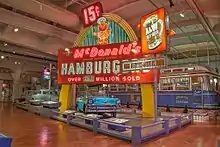McDonald's sign (Pine Bluff, Arkansas)
The McDonald's Sign, also known as McDonald's Store #433 Sign, in Pine Bluff, Arkansas, United States, is one of only a few surviving examples of a single-arch McDonald's sign. The sign was erected in 1962 and remained at its original location until 2007. That year, McDonald's Store #433 moved and the sign was renovated and moved to the new location. The McDonald's sign was added to the U.S. National Register of Historic Places in 2006.
McDonald's Store #433 Sign | |
 | |
 Location in Arkansas  Location in United States | |
| Location | 2819 S. Olive St., Pine Bluff, Arkansas |
|---|---|
| Coordinates | 34°12′7″N 92°0′24″W |
| Area | less than one acre |
| Built | c. 1962 |
| Architectural style | Single-arch McDonald's sign |
| NRHP reference No. | 06000411[1] |
| Added to NRHP | August 21, 2006 |
History
Before McDonald's Store #433 was built on South Main Street in Pine Bluff, the neighborhood was mostly residential. The area began to change as the mid-20th century approached and commercial enterprises began to appear in the area. The McDonald's was constructed at 1300 South Main Street in 1962 and followed the standard corporate design for the era: a red, white and yellow motif with arches projecting through the roof (owned by Mike Retzer).[2]
McDonald's Store #433 opened on July 3, 1962, and remained in operation until it was announced in August 2007 that the store would close by the end of the year.[3][4] A new location was constructed in the 2800 block of South Olive Street, about two miles from the original location. Initially, it was unknown what the sign's fate would be; by September, it was announced that the sign would move to the new location.[3][4]
As the date of closure approached in September the sign was dismantled and transported to Skylite Sign & Neon in Mabelvale, Arkansas, for renovation work which lasted through October 2007.[5]
Design
The McDonald's sign in Pine Bluff represents a transition between the "Speedee" sign and the now-ubiquitous double golden arches. The design featured in Pine Bluff was used for one year and was relatively rare even when it was being used, even more so today.[2] The first double golden arches sign appeared just three months after the Pine Bluff store opened.[3]
Typical of the single-arch style from McDonald's early years, the Pine Bluff sign has plastic panels held in a metal frame and red advertising space midway up the sign. The sign was manufactured by Sign Crafters of Evansville, Indiana and the plastic sheeting was made by Rohm & Haas Company of Philadelphia.[2]
Ray Kroc designed the sign after seeing an image of the McDonald family crest.[2] The arch itself evokes modernism. In Orange Roofs, Golden Arches: The Architecture of American Chain Restaurants Phillip Langdon stated the arch was symbolic of a "buoyant spirit: a feeling of skyward momentum, symbolic of an aerospace age in which man could hurtle himself into the heavens."[2] Langdon goes on to state that the purpose of the McDonald's arch was to bring a sense of structural modernism in a roadside hamburger stand.[2]
Historic significance


The U.S. National Register of Historic Places added the Pine Bluff McDonald's sign to its listings on August 21, 2006, as McDonald's Store #433 Sign.[1] McDonald's has used a variety of designs for its signs; consequently, early examples are exceedingly rare.[2] The sign in Pine Bluff, Arkansas' only known surviving example of an early single arch McDonald's sign, is also a good example of a rare early backlit plastic sign. Backlit plastic signs were popularized post-World War II and revolutionized the sign industry through the 1950s and 60s.[2]
It remains unclear exactly how many single-arch McDonald's signs remain nationwide. Before Hurricane Katrina in 2005, one was still in use in Biloxi, Mississippi.[3] The store on MacArthur Boulevard in Springfield, Illinois, also had a single arch up until 2006. Others exist in Magnolia, New Jersey;[7] Green Bay, Wisconsin;[8] St Clair Shores, Michigan; Warren, Michigan; Montrose, Colorado; Independence, Missouri; Winter Haven, Florida; Belleville, Illinois; and Muncie, Indiana. A sign is also on display in The Henry Ford museum in Dearborn, Michigan. The sign in Pine Bluff, which has been removed as of October 2023, was the only such sign that has its own listing on the National Register, though a few others may exist as contributing properties within historic districts. It is likely that most single-arch signs were incorporated into private collections.[3]
See also
References
- "National Register Information System". National Register of Historic Places. National Park Service. July 9, 2010.
- "McDonald's Store #433 Sign Archived 2013-01-17 at archive.today," Property History & Architecture, Arkansas Historic Preservation Program, accessed January 1, 2013.
- Linn, Mike. "McDonald's gets one-arch, '62 sign to go", Arkansas Democrat Gazette, September 25, 2007, accessed April 22, 2008.
- Duke, Richard. "Historic sign may not move with restaurant," Pine Bluff Commercial (Pine Bluff, Arkansas), August 16, 2007, accessed April 22, 2008.
- Nugent, Jeannie. "Restoring the golden arch," Pine Bluff Commercial (Pine Bluff, Arkansas), October 27, 2007, accessed April 22, 2008.
- Dan Gleiter [@DanGleiter] (20 April 2016). "McDonald's 1962-era single-arch sign in Lancaster County is being dismantled, @PennLive" (Tweet) – via Twitter.
- "McDonald's Sign | Magnolia, New Jersey. | G W | Flickr". 19 November 2005. Retrieved Nov 17, 2020.
- "McDonald's Sign 4099 | Erected in roughly 1960 this McDonald… | Flickr". 15 June 2009. Retrieved Nov 17, 2020.
Further reading
- Auer, Michael J. "The Preservation of Historic Signs", Preservation Brief #25, October 1991, National Park Service, accessed April 22, 2008.
- Langdon, Philip. Orange Roofs, Golden Arches: The Architecture of American Chain Restaurants, (Google Books), Joseph, 1986, (ISBN 0-7181-2788-9).